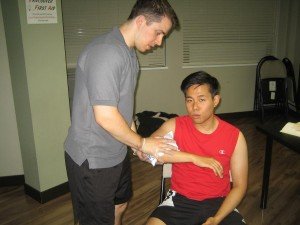It is important to note that scars and wounds whether caused by injury or as a result of surgical procedures should heal quickly and properly in order to reduce the risk for infection and scarring. This is why it is vital to pay close attention to the instructions given by the doctor on how to care for the wound. By cleansing and dressing a wound properly, it must heal correctly with minor scarring. Remember though that scarring is a natural part of the healing process and typically improves on its own.
Cleansing the wound
You have to clean the wound on a daily basis in order to avoid infection. All you have to do is to create a saline solution by combining a cup of warm water and a teaspoon of salt and mix until fully dissolved. Pour the solution directly over the wound.
You can also utilize an antibacterial soap. Create lather and pat a small amount of the lather over the wound and leave the suds for about 20 seconds and then rinse using cool water.

Cover the wound
You have to cover the wound only if it is located in an area prone to getting dirty or where it can reopen while engaging in daily activities. Otherwise, simply leave the wound open to the air and keep it dry for faster healing. A doctor should be consulted whether to leave the wound open or cover with a bandage. When it comes to large-sized wounds such as rashes and scrapes, they heal better in a moist environment.
Avoid touching the wound
The individual should keep his/her hands away from the wound. Even though it can be tempting to pick on, touch or peel the scab or scar, remember that it can transfer dirt and germs from the hands into the wound opening. Understandably, this puts the individual at risk for infection and swelling as well as a slower healing time which leads to scarring.
Monitor for signs of infection
Always watch out for indications of infection and consult a doctor if there is redness, swelling, pain or a milky liquid discharge from the wound. Remember that infection disrupts the healing process and can cause added discomfort. A doctor should be consulted right away so that antibiotics can be given to stop the infection and continue the healing process.
Application of silicone gel pads or creams
You can utilize silicone gel pads or creams on the healing wound on a daily basis once the wound closed up. Silicone gels are effective in reducing the scarring. In addition, microdermabrasion or exfoliating the scar using an abrasive material can also smooth the skin out and minimize puffiness so that the scar is less noticeable and flushes with the rest of the skin.
In case the scar bothers the individual or heals badly, the doctor might recommend scar revision or laser resurfacing to achieve smoother skin.
